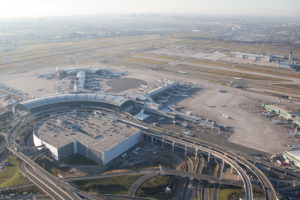By Brett Bain
Historically, things in airports around parking and transportation have until the last few years, been static. Customers generally followed three standard options for getting to the airport. They drove themselves and parked their vehicle at the airport, they took a taxi or limousine, or they were dropped off by a friend or family member.
Airports in Canada – in most cases – are non-profit organizations that operate under a lease arrangement with the federal government. They do not receive any funding from the government to operate and in fact, pay a minimum of 10% of gross revenues in tax back to the federal government. In addition, they are also required to pay property tax to the jurisdiction in which they reside. As a result, Canadian airports are very reliant on the revenue generated from non-aviation sources which consists primarily of parking, concessions within the airport and real estate revenues. These revenues are reinvested back into the airport for operational expenses and for airport infrastructure and flight development.
Like many businesses, airports have been in transition over the last few years. If we think back a bit, we can all remember that at one time telephone, internet and cable companies were all separate entities which provided a product or service to their customers. These businesses have all blended together into single entities over the last few years as technology has created opportunities for companies to enter into new markets. Parking and transportation at airports are now in the early stages of a similar transformation as transit and/or rail services begin to appear in the airport offerings. Airports are both an economic driver for their region and a reflection of the community which they serve. As cities develop new and expanded forms of transportation to serve their citizens, these are also…
By Jennifer Mucha
Toronto Pearson is Canada’s largest airport, and the ninth-busiest airport in North America, moving nearly 50 million annual passengers from security checkpoint to gate to more than 170 destinations around the world. The airport has a mandate to put passengers at the heart of every decision, and as a result was recently recognized by the Airports Council International as the Airport Service Quality best large airport in North America. Believing that the passenger experience starts long before take-off, Toronto Pearson is using technology and analytics to build a diverse and creative transportation offering that ensures travellers have an end-to-end experience tailored to their individual needs, while keeping future aviation demand in its sights.
Toronto Pearson has come a long way from its origins in a farmer’s field in the village of Malton in 1939. The airport grounds now stretch from Mississauga in the west to the city of Toronto in the east and south, and to Brampton in the north. At the heart of three municipalities and close to the 400-series highways, it goes without saying that Toronto Pearson sees high vehicle traffic from passengers, meeters, greeters and employees.
Integrating Parking and Transportation
With nearly 50 million annual passengers, as well as an airport employee community of almost 50,000 workers, efficient transportation into and out of the airport is critical to the success of the operation. An intricate network of municipal transit providers, ground transportation operators and the airport’s own Parking and Ground Transportation business unit work together with a common goal: to ensure that transportation at the airport is integrated, provides a diverse and appropriate range of services and contributes to the airport’s passengers-first mandate.
Achieving that goal is no small feat. Toronto Pearson’s three covered garages and two outdoor lots represent Canada’s…
By Chris Mckenty
Canadian airports, unlike most of their American counterparts, are operated by non-share, not-for-profit airport authorities and are mandated to operate as self-sustaining businesses. This gives them greater freedom to adopt new technology pricing and marketing strategies that help them reach their goals. This is especially the case in commercial areas like parking.
Canadian airports, unlike most of their American counterparts, are operated by non-share, not-for-profit airport authorities and are mandated to operate as self-sustaining businesses. This gives them greater freedom to adopt new technology pricing and marketing strategies that help them reach their goals. This is especially the case in commercial areas like parking.
In the past few years, this technology has included the ability to give their customers the option to book and pre-pay for their car parking online via the Canadian’s Airports website or mobile app. You might be surprised to learn that last month alone (June 2014) nearly 10,000 fully prepaid parking bookings were made at just 3 of Canada’s airports generating an additional $750,000 of revenue for the airports. Edmonton Airport is predicted to grow its pre paid parking by 40% annually over 2015.
With this greater freedom the incentives and drivers for change can vary depending on the dynamics at each Airport,however common factors are apparent. These include:
- Increasing competition from off airport car parks
- Under budget achievement for car parking revenue
Spare parking capacity or very limited capacityin the car parks - A desire to improve customer service
Another significant factor in the decision to adopt this new technology is the lack of specific information on who the passengers and Airport customers are. Airlines have long since had access to this data but for many reasons have been either unable or unwilling to share this detailed traveller data. By offering an online reservation solution for their car parks, the Airports…





